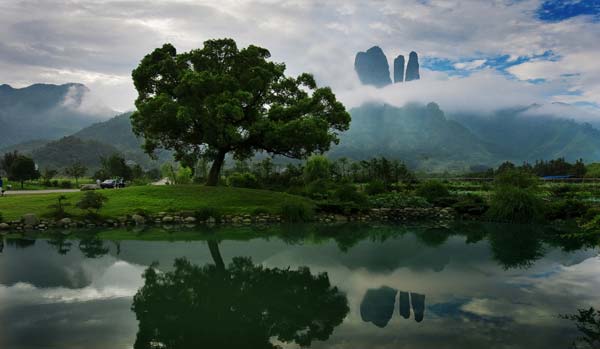

Three peaks of Mount Jianglang loom over a pond in Jiangshan city, Zhejiang province. Photo provided to China Daily
Jiangshan city in Zhejiang province is the perfect place to be on weekends if you like ancient towns soaked in history, with a bit of mountain trekking thrown in. You can start your journey in the morning by climbing Mount Jianglang, which overlooks the city on it, with three of its peaks higher than 300 meters.
Jianglang is part of China Danxia that was declared a world heritage site by UNESCO in 2010. Chishui, Taining, Mount Langshan, Mount Danxia and Mount Longhu are other parts of the Danxia that spread across six neighboring provinces in southern China.
The Danxia landform was developed on red sedimentary beds since the Neogene Period, and witnessed much wear and tear through movements of rocks, erosion and weather conditions. The landform comprises magnificent red cliffs, natural pillars, towers, valleys and waterfalls.
Between Mount Jianglang's two peaks is a "crack" that is around 298 meters long and tapers down to a pathway with a width of about 3.5 meters. Tourists can walk through the crack on stone steps and peep into the sky for a stunning view.
Last autumn, Jeb Corliss, a professional sky diver from the United States, jumped out of a helicopter in a wingsuit at an altitude of 500 meters and flew through the crack successfully. Among Corliss' earlier successes include plunging from the Eiffel Tower in Paris and the Petronas Twin Towers in Kuala Lumpur.
"To attract more tourists we are speeding up infrastructure building at Mount Jianglang. There's a huge investment in expansion of parking lots (for example)," says Jiang Li, deputy head of Jiangshan's publicity department.
In 2013, the tourism bureau of Jiangshan opened an online store on Tmall.com, a leading Chinese e-commerce site, to sell tickets and hotel accommodation at scenic places.
Qingyang village with its ancient temples and houses could be your next stop in Jiangshan. It is known for its deep association with the surname Mao. Many people bearing the surname had lived in areas toward the south of the Yangtze River.
In 1999, experts confirmed that Mao Zedong's ancestors used to live in Qingyang, before moving to Shaoshan in Hunan province. The village is also the ancestral home of Mao Fumei, Chiang Kai-shek's first wife, and Chiang Ching-kuo's mother.
However, Mao and Chiang never knew about the connection, as they died more than 30 years prior to the discovery.
The other house of interest in the village once belonged to the family of Dai Li.
Dai worked for Chiang Kai-shek, as head of a bureau that specialized in surveillance, kidnapping and assassinations, and also engaged in espionage activities against the Japanese in the War of Resistance against Japanese Aggression (1937-45). Dai died in a mysterious airplane crash in 1946.
Built in 1943, with some 85 doors and 122 windows, Dai's house seemingly reflects the personality of an intelligence agent. His study has six doors through which escape in an emergency situation would have been quick.
A traditional Chinese landscape painting had once graced the sitting room wall. Above the room's gate is a small cabinet where Dai kept his gun. A secret chamber behind the wall where he used to live, protected by personal armed guards, is also difficult to make out at first glance.
Another spot that you could visit is Xianxiaguan on Mount Xianxia. Because of the surrounding terrain, Xianxiaguan was a fortress in ancient times, and is located at a little distance from Dai's house. Additionally, you can enjoy the greenery and fresh air over the Xianxia ancient road that was used for trade with Fujian province.
The road will lead you to the town of Nianbadu, one of the most coveted military bases in ancient China, where troops from all over the country were stationed. The town has people with about 142 surnames, who speak in some 13 dialects.
There are many buildings here from the Ming (1368-1644) and Qing (1644-1911) dynasties and from the 1910s onward. Well-preserved arches over gateways feature delicate carvings of plants and animals.
IF YOU GO
Tourists from Beijing, Xiamen and Shenzhen can fly to Quzhou airport, which is only 36 kilometers from the Jiangshan downtown. Jiangshan is 288 kilometers from Hangzhou, capital of Zhejiang province. It takes less than four hours by high-speed trains from Shanghai to Jiangshan. The city is rich in agricultural products such as honey, royal jelly and white mushrooms. You could taste authentic farmhouse dishes including fresh potherb, tofu soup and stewed fish in Nianbadu.
SILK TOUCH
Xinchang city in Zhejiang province is less than four hours by car from Jiangshan or Shanghai. There you can visit the Dafo Temple with a history of over 1,600 years, to see a 15-meter-tall Buddha statue carved inside a grotto. There are three wells on the back of the Buddha's head for water to drain out during rain or snowfall.
After sipping a cup of the famous Dafo Longjing tea, you can go to the Chongyang Palace to learn more about Taoism. Located at the Nineteen Peaks Scenic Area, the temple has attracted many famous Taoist scholars and poets.
You can also go to High Fashion Silk World Industrial Tourist Zone to learn about Chinese sericulture and the modern weaving industry. The Silk Culture Museum shows how silk products were made, right from the rearing of silkworms to spinning silk threads. Visitors can pluck ripe mulberries, grapes and vegetables, and see rapier looms and digital jacquard looms at workshops.
You can also buy pretty silk scarves, bed sheets and quilt covers with elegant designs at souvenir stores.
Nature works its magic in Chongqing
2014-06-27Copyright ©1999-2018
Chinanews.com. All rights reserved.
Reproduction in whole or in part without permission is prohibited.